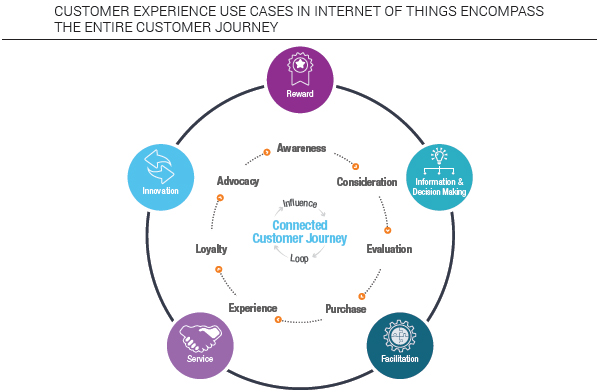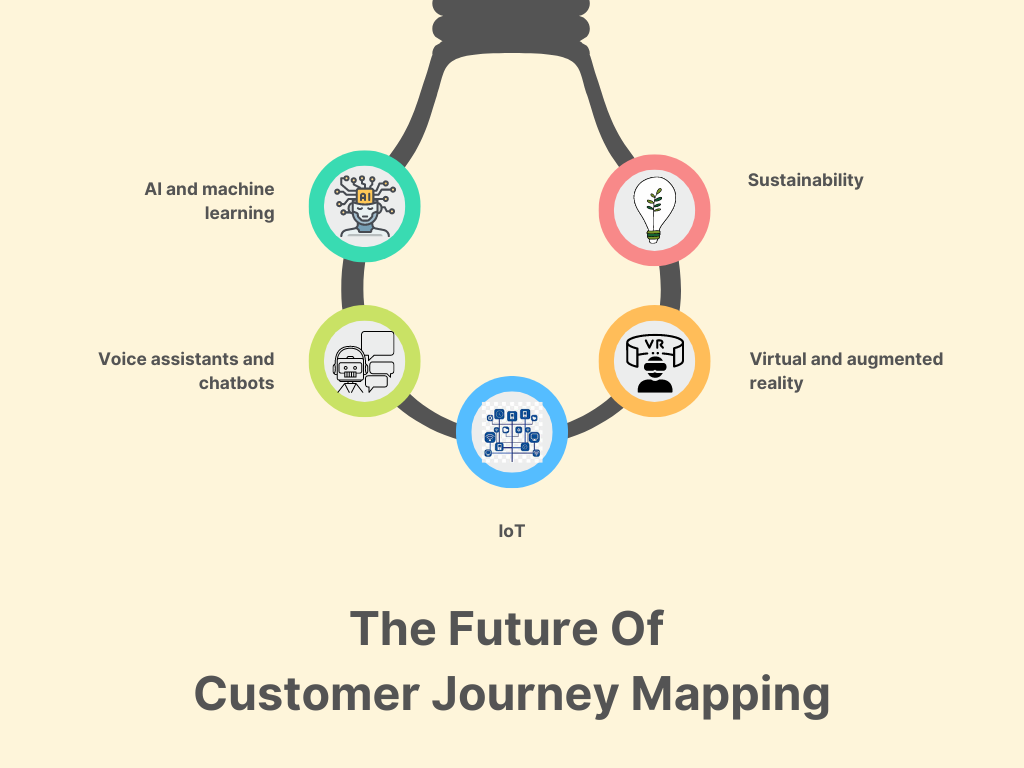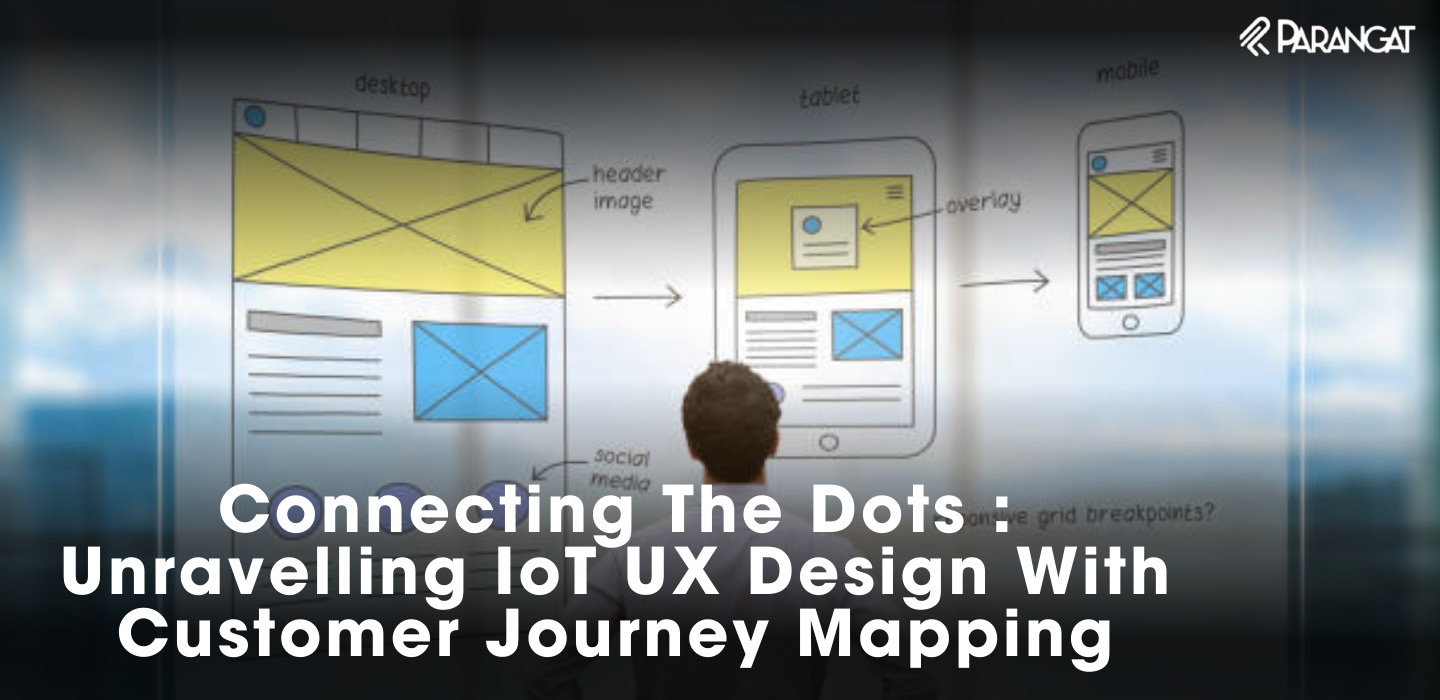In the dynamic realm of technology, the Internet of Things (IoT) has emerged as a transformative force, intertwining the Artificial Intelligence Development Services Company and physical worlds. This blog explores the intricate relationship between IoT UX design and Customer Journey Mapping, delving into the key concepts, challenges, and strategies that shape the user’s experience in the interconnected web of IoT devices.
By the year 2019, the majority of marketers – 81% to be precise – anticipate that they will primarily or entirely focus on competing based on Customer Experience (CX), as revealed by the 2017 Gartner Customer Experience in Marketing Survey.
Understanding IoT UX Design
UX design for the Internet of Things (IoT) is a complex field that aims to enhance user-device interaction within the interconnected IoT environment. Enterprise AI Development Company focuses on developing interfaces that are user-friendly and intuitive on various devices while also being visually attractive.
Unlike traditional UX design, IoT UX extends beyond a single device to consider the intricate relationships and seamless flow of data between interconnected devices. Designers must navigate the challenges of diverse user contexts, varying device capabilities, and real-time communication between devices to create a cohesive and harmonious user experience.
The Complexity of IoT Ecosystems
The interconnected nature of smart devices adds a layer of complexity to UX design in IoT. Designers are confronted with the task of developing interfaces that can smoothly adjust to the distinct characteristics of various devices.
To design user experience for IoT ecosystems, designers must address data security and privacy to ensure user confidence and protection. AI Development for Startups and Enterprises is essential to take a comprehensive approach, understanding the interconnectedness and dynamics among devices rather than just their isolated functionality.
Key points include:
- Addressing data security and privacy
- Ensuring user confidence and protection
- Designing user experience for IoT ecosystems
- Taking a comprehensive approach
- Understanding interconnectedness and dynamics among devices
Customer Journey Mapping in IoT
Mapping the customer journey within the Internet of Things (IoT) context needs visualization and awareness of the complete user experience while they shift across interconnected devices. It goes beyond mapping a linear path and encompasses the totality of a user’s interaction with the IoT ecosystem.
Customer Journey Mapping- CJM authorizes designers to determine touchpoints, pain points, and moments of delight throughout the user’s journey, providing a comprehensive view of the user’s experience. By visualizing this journey, designers gain insights into the ways users interact with devices, the transitions between devices, and the overall fulfillment and challenges experienced along the way.
Mapping the Connected Landscape
Customer Journey Mapping for IoT implicates developing a visual representation of how users move through the interconnected landscape of devices. This mapping expands from the initial interaction with a single device to the seamless transition between numerous devices within the IoT ecosystem. Understanding the user’s journey comprises recognizing entry points, device switches, and exits from the ecosystem.
Designers must contemplate the holistic experience, identifying moments where the user may encounter friction or chaos and seeking chances to improve the overall journey. By mapping the related landscape, designers can pinpoint regions for modification, optimize transitions, and develop a cohesive and delightful user experience across the whole AI app development company.
Challenges in IoT UX Design and Customer Journey Mapping
IoT UX design and Customer Journey Mapping pose numerous challenges due to the complex interactions between different devices and their functionalities. The intricate interplay of various devices adds layers of complexity to the design process. Ensuring a seamless and intuitive user experience across different devices with unique interfaces and capabilities is a persistent challenge in IoT UX design.
Data security and privacy are crucial in IoT due to sensitive information exchange. Customer Journey Mapping in IoT involves visualizing the user’s journey across interconnected devices. Designers face challenges in mapping transitions, touchpoints, and potential pain points in a dynamic landscape of Artificial intelligence solutions. Here are ten key challenges in IoT UX design and Customer Journey Mapping:
1. Device Compatibility and Consistency
Designers face the challenge of ensuring a consistent and compatible user experience across a diverse array of IoT devices. Achieving a uniform interface while tailoring the experience to the capabilities of each device poses a significant design challenge.
2. Data Security and Privacy Concerns
The exchange of sensitive data in the IoT ecosystem raises concerns about data security and user privacy. Designers must implement robust security measures and communicate transparently about data usage to build and maintain user trust.
3. Seamless Device Integration
Enabling seamless transitions between devices is crucial for a positive user experience. Designers need to ensure that users can switch between devices effortlessly while maintaining continuity in their tasks and interactions.
4. User Context Variability
IoT devices are used in diverse contexts, from smart homes to industrial settings. Designers must account for the variability in user contexts, ensuring that the UX remains effective and intuitive across different scenarios.
5. Real-Time Communication Challenges
The real-time communication between interconnected devices introduces challenges in synchronizing data and maintaining a smooth flow of information. Designers must address potential delays or disruptions in communication to uphold a seamless user experience.
6. Diverse User Skill Levels
IoT devices cater to users with varying levels of technical proficiency. Designers must create interfaces that are intuitive for both tech-savvy users and those less familiar with technology, striking a balance in usability for diverse user groups.
7. Managing Complexity in Interactions
As the number of interconnected devices increases, managing the complexity of user interactions becomes a challenge. Designers must simplify the user journey without sacrificing functionality or overwhelming users with unnecessary features.
8. Balancing Customization and Standardization
Providing customization options for users while maintaining a standardized and coherent interface is a delicate balance. Designers must offer flexibility without compromising the overall user experience or creating confusion.
9. Ensuring Accessibility and Inclusivity
Designing for accessibility becomes crucial in the IoT landscape, where users may interact with devices in various ways. Ensuring that interfaces are inclusive, considering diverse abilities and needs, is a challenge for UX designers.
10. Evolving Technology Landscape
The rapid evolution of IoT technologies poses an ongoing challenge for designers. Staying abreast of emerging technologies, such as augmented reality and artificial intelligence, and incorporating them seamlessly into the UX design process requires adaptability and continuous learning.
Strategies for Effective IoT UX Design
Effectively navigating the intricate world of the Internet of Things (IoT), UX design demands a strategic approach that addresses the unique challenges posed by interconnected devices. Designers must consider factors such as device compatibility, seamless integration, and the diverse contexts in which IoT devices are used.

Crafting an optimal user experience involves strategic thinking and the implementation of proven strategies. Here are ten strategies for effective IoT UX design:
User-Centric Approach
Prioritizing a user-centric approach involves understanding the diverse needs, behaviors, and preferences of users interacting with IoT devices. Designers must empathize with users’ perspectives and create interfaces that resonate with different user profiles, ensuring a positive and inclusive user experience.
Seamless Device Integration
Enabling seamless device integration requires designing interfaces that allow users to transition effortlessly between interconnected devices. Consistency in the user experience across devices ensures a fluid and continuous interaction, minimizing disruptions and enhancing overall usability.
Iterative Design and Testing
Embracing an iterative design process involves continuous testing and refinement based on user feedback. This agile approach allows designers to identify and address issues promptly, adapting the UX to evolving user needs and technological advancements.
Context-Aware Design
Context-aware design entails creating interfaces that adapt to different user scenarios and environmental contexts. By considering the varied situations in which IoT devices are used, designers can tailor the user experience, providing relevant and timely information.
Customization with Standardization
Balancing customization with standardization requires offering users flexibility while maintaining a consistent interface. Providing options for personalization allows users to tailor their experience, enhancing engagement without compromising the overall coherence of the UX.
Clear Communication
Transparent communication involves clearly conveying information about data usage, security measures, and privacy concerns to users. Establishing trust through open communication is essential for users to feel confident and secure when interacting with IoT devices.
Human-Centered Design Principles
Applying human-centered design principles emphasizes empathy, inclusivity, and accessibility. Designers must consider the diverse abilities and needs of users, ensuring that interfaces are intuitive and accommodating for a broad range of individuals.
Scalability in Design
Designing with scalability in mind enables interfaces to adapt to the evolving nature of IoT ecosystems. This approach ensures that the UX remains effective as new devices, technologies, and functionalities are introduced to the interconnected landscape.
Cross-Functional Collaboration
Fostering cross-functional collaboration involves effective communication among designers, developers, and engineers. A cohesive approach to problem-solving ensures that diverse perspectives contribute to creating a holistic and well-rounded IoT user experience.
Education and Training Initiatives
Investing in education and training initiatives involves providing users with clear guidance on the functionalities of IoT devices. Intuitive interfaces and comprehensive onboarding processes contribute to user understanding, promoting a smooth and informed adoption of IoT technologies.
By incorporating these strategies into the design process, UX designers can create interfaces that not only meet the challenges of the IoT landscape but also provide users with intuitive, seamless, and enjoyable interactions across interconnected devices.
Case Studies: Successful Implementations of IoT UX Design and Customer Journey Mapping
Smart Home Ecosystems
AI as a service flourishing smart home ecosystems showcases the importance of IoT UX design and Customer Journey Mapping in shaping unified and pleasurable user experiences. Nest and Philips Hue are standout examples of seamlessly integrating devices and providing users with a streamlined and user-friendly control interface.
Wearable Technology
Effective IoT UX design is exemplified by the success of wearables such as the Apple Watch in the realm of technology. By engaging in meticulous Customer Journey Mapping, Apple has successfully integrated the wearable device into the user’s daily routine, providing a user-centric experience.
The Future of IoT UX Design

The future of Artificial Intelligence in business development holds exciting possibilities as technological advancements continue to shape the interconnected landscape. As IoT evolves, designers are faced with the challenge of staying ahead of emerging technologies and user expectations. The future will likely see a convergence of innovative technologies, pushing the boundaries of what is possible in terms of user interaction with smart devices.
An increased focus on sustainability, inclusivity, and the seamless integration of new interfaces, such as augmented reality (AR) and artificial intelligence (AI), will play pivotal roles in shaping the future of IoT UX design. Here are several key aspects that characterize the anticipated future of IoT UX design:
Integration of Augmented Reality (AR)
The incorporation of AR into IoT interfaces is poised to revolutionize user interactions. AR will enable users to overlay digital information onto the physical world, enhancing the real-time relevance and contextual awareness of IoT devices.
Enhanced Artificial Intelligence (AI) Integration
The future will witness deeper integration of AI to enhance personalization and predictive capabilities in IoT UX design. AI algorithms will analyze user behaviors, preferences, and patterns, allowing devices to anticipate user needs and adapt in real-time.
Gesture and Voice Controls
Gesture and voice controls will become more prevalent, offering users alternative and intuitive ways to interact with IoT devices. As natural language processing and gesture recognition technologies advance, these modalities will provide more seamless and accessible interactions.
Emphasis on Sustainability
Sustainable design principles will take center stage in IoT UX, aligning with the growing emphasis on environmental responsibility. Designers will focus on creating energy-efficient interfaces and promoting eco-friendly practices in the usage of interconnected devices.
Inclusive Design for Diverse Users
The future of IoT UX design will prioritize inclusivity, ensuring that interfaces are accessible to users with varying abilities and needs. Designers will embrace universal design principles to create experiences that cater to a diverse user base.
Multi-Modal Experiences
Users will experience multi-modal interfaces that seamlessly combine various interaction modes, such as touch, voice, and gestures. This approach will offer flexibility, accommodating users’ preferences and the capabilities of different devices.
Ephemeral Interfaces
Ephemeral interfaces, which appear and disappear as needed, will gain prominence. These dynamic interfaces will contribute to a clutter-free and distraction-free user experience, presenting information only when relevant.
Blockchain for Security and Privacy
The development of blockchain technology will enhance security and privacy in IoT interactions. Blockchain’s decentralized and secure nature will play a crucial role in safeguarding user data and building trust in IoT ecosystems.
Edge Computing for Real-Time Processing
Edge computing will become integral to IoT UX design, enabling real-time data processing closer to the source. This approach minimizes latency, enhances responsiveness, and supports more dynamic and interactive user experiences.
Adaptive Interfaces for Evolving Ecosystems
Designers will focus on creating adaptive interfaces that can evolve with the dynamic nature of IoT ecosystems. These interfaces will seamlessly accommodate new devices, technologies, and user preferences, ensuring a future-proof user experience.
Also read: IoT In Smart Parking Management: Benefits & Challenges
Conclusion
In the intricate dance between IoT UX design and Customer Journey Mapping, designers navigate a landscape where each connected device contributes to a broader narrative of user interaction. By understanding the Artificial Intelligence Software Development Company challenges, embracing effective strategies, and learning from successful case studies, designers can shape the future of IoT experiences.
As we look ahead, the convergence of innovative technologies and a relentless focus on user-centric design promises a future where the dots of the IoT ecosystem seamlessly connect, creating a user experience that is not only intuitive but also enriching is the only goal of Parangat. Reach us for any IoT-related queries.





